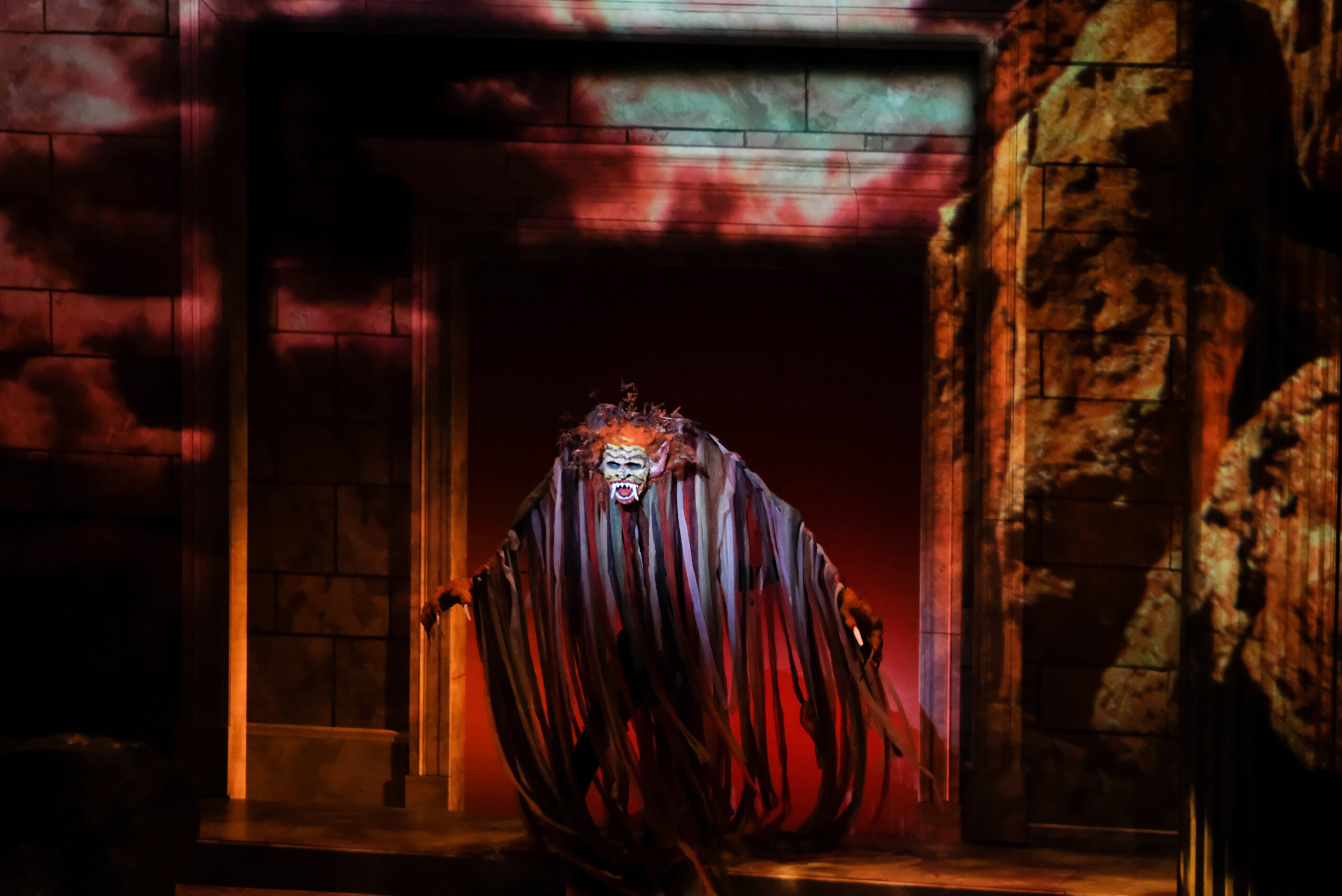Posted
A new production for the 25-year-old company, the opera was well cast and appropriately adjusted for modern times.

Tamino, in the foreground, played by Geoffrey Agpalo performs on stage as a monster, operated by puppeteer Ian Bannon, approaches in the background during the opening night of Opera Maine’s production of “The Magic Flute” at Merrill Auditorium Wednesday. Shawn Patrick Ouellette/Staff Photographer
Opera Maine is celebrating its 25th anniversary with an attractive, solidly sung production of Mozart’s “The Magic Flute,” its first presentation of the work.
It almost goes without saying that, on purely musical grounds, “The Magic Flute” is a spectacular work. Technically a Singspiel, it has stretches of spoken monologues and dialogues, which Opera Maine presented in English, amid arias, duets and choruses, which are sung in German here. Because Mozart tailored these pieces to the skills of the singers in the work’s first production, in 1791 (just over a month before his death, at 35), they range from relatively easygoing, even a bit folksy (for example, the music for Papageno, the comic birdcatcher) to stunningly virtuosic (the Queen of the Night’s two high-flying showstoppers).
But the work’s libretto, by Emmanuel Shikaneder, has elements that raise eyebrows in 2019. A fantasy in which Prince Tamino, with Papageno at his side, must find and win the love of Pamina, with whom he becomes an initiate into Sarastro’s temple of wisdom, truth and love – a society that was, for Mozart and Shikaneder, a metaphor for Freemasonry – it is replete with turns that today would raise red flags over race and gender issues.

Tamino catches Papageno during the opening night of Opera Maine’s production of The Magic Flute at Merrill Auditorium Wednesday. Tamino was played by Geoffrey Agpalo and Papageno was played by Robert Mellon. Shawn Patrick Ouellette/Staff Photographer
The Opera Maine production, directed by Dona D. Vaughn, the company’s artistic director, worked hard to skirt those issues, partly by fielding a cast far more diverse than Mozart would have imagined, and in some cases, with deft editing.
One example: Monostatos, the overseer of the slaves, is a Moor, which the company acknowledges by decorating his headquarters with geometric designs in an Islamic style. Historically, the role was sung in blackface, but that notion is a non-starter today. Moreover, the cast’s excellent Pamina, Brandie Sutton, is black. That made a bit of dialogue between her and Papageno awkward, as written: Referring to Monostatos, Papageno notes that he has seen black birds, so why shouldn’t there be black people? That line is increasingly deleted these days, and Opera Maine sensibly deleted it here.
The production was an inventive demonstration of how technology can overcome budget constraints. Erhard Rohm’s sets are deceptively simple – angled flats painted as light-colored stone walls, a couple of large pillars and a doorway, mainly. But Kate Ashton’s lighting and Alex Basco Koch’s projections (including film, which makes Tamino’s and Pamina’s trials by fire and water seem dynamic rather than static) create the illusion of frequent set changes.
Add to this Millie Hiibel’s costumes, which range from traditional (Sarastro and his followers wear long robes; Papageno and Papagena, his mate, are heavily feathered, and Monostatos wears a turban) to amusingly odd (the Three Ladies, emissaries of the Queen, wear large crow heads that make them look like space aliens; the Three Spirits, in post-punk hairdos, wear shoes with rollers that allow them to glide across the stage).
The company’s cast was generally strong. Tenor Geoffrey Agpalo, though not the most overtly heroic Tamino, sensibly brought out the prince’s sensitivity and steadfastness. Sutton’s Pamina was somewhat more refined, and projected the sense that being tugged in so many different directions by the Queen of the Night (her mother), Sarastro, Monostatos and Tamino has made her a more mature character than Tamino – which, in turn, clarified the degree to which Tamino’s trials were (Masonic ritual notwithstanding) meant partly as a way to make him grow up, to be worthy of Pamina.
The Queen of the Night is often played with greater dramatic posturing than soprano Kathryn Bowden brought to the role, but her approach suited this production perfectly. A high-drama portrayal accepts Shikaneder’s characterization of the queen as a villainess, but if you’re reconsidering the libretto, you have to admit that she may have legitimate grievances.
In any case, Bowden’s performances of the queen’s arias were extraordinary; in her second act showpiece, “Der Hölle Rache” (“Hell’s Vengeance”), she sang the stratospheric Ds and Fs as if hitting them was the easiest thing a soprano could be asked to do.
Baritone Robert Mellon played Papageno with a millennial touch and did a fine job vocally; soprano Yeonji Lee matched his comic pacing nicely as Papageno.
Hidenori Inoue, who did stellar work in the 2017 Studio Artist production of Jack Perla’s “An American Dream,” was less fully suited to Sarastro. He has the notes, and he captured much of the role’s dignity and depth, but not quite the power and heft that Sarastro demands.
Roberto Kalb, who joined the production at the last minute, when conductor Stephen Lord bowed out after singers at other companies complained of sexual harassment, led a thoughtful, well-paced and often exciting performance.
Allan Kozinn is a former music critic and culture writer for The New York Times who lives in Portland. He can be contacted at: [email protected]
Twitter: kozinn

